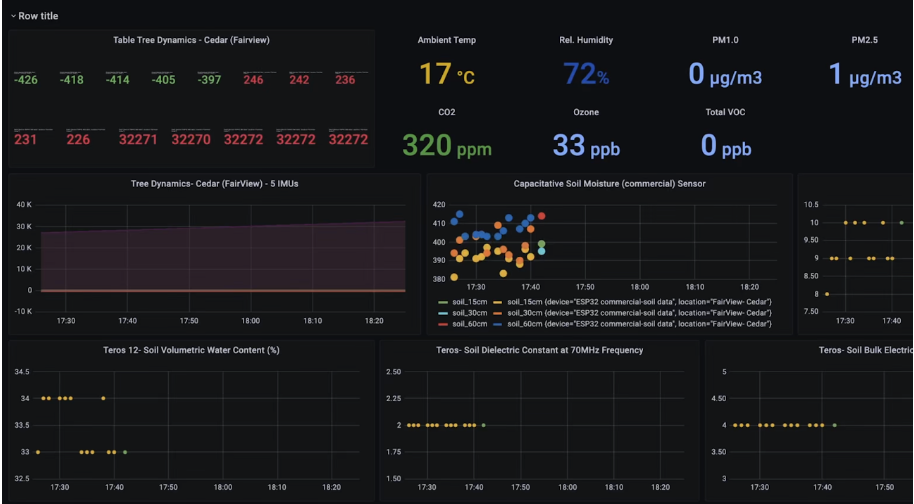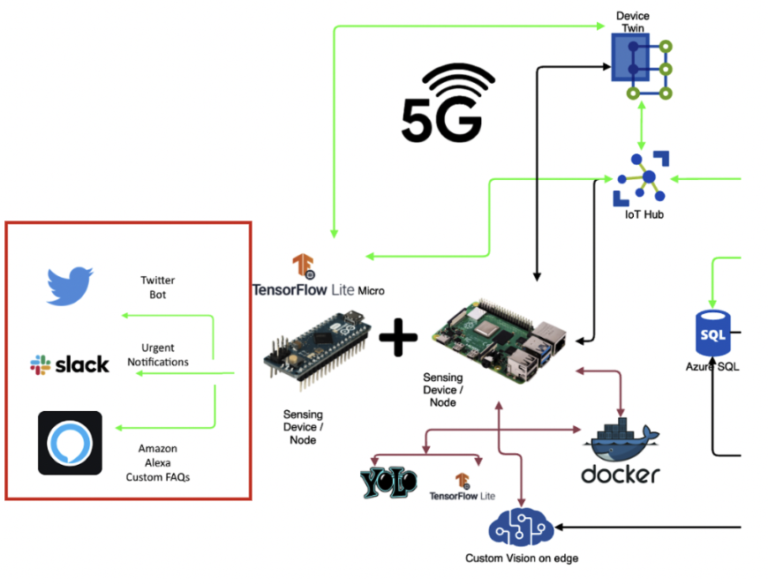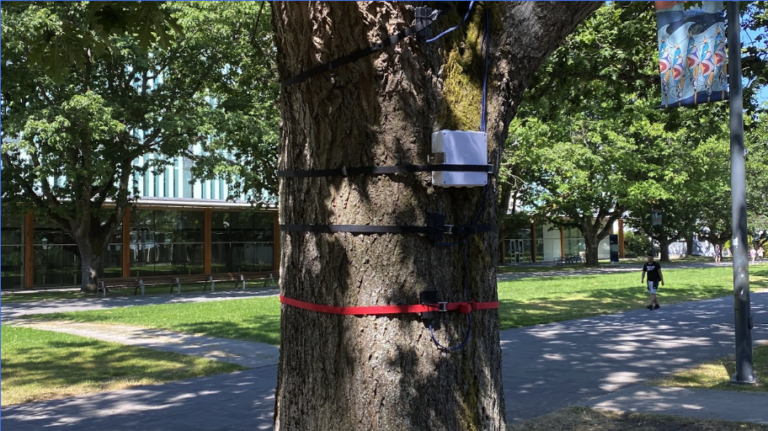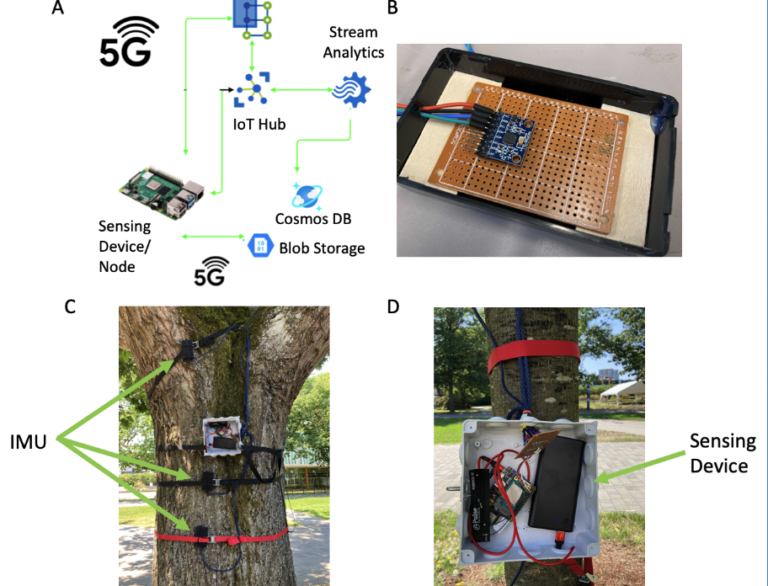Project Overview - The Research Team at UBC
The Internet of Things In Urban Forestry
Issues include long emergency room wait times, overworked medical staff, understaffed medical facilities with overburdened staff, and stressful working conditions for first responders and medical staff:
The internet of things, or IoT, is an ecosystem that interconnects a system of devices to the internet. It encompasses every thing – from smartphones, wearables, simple sensors to environmental monitoring systems. Typically, in an IoT system, a network of Internet-connected devices communicate sensor data to the cloud for visualization or further processing.
These sensors are often used as monitoring devices for parameters. In a smart thermostat for example, the sensor is measuring temperature and humidity. The sensors stream the data, also known as telemetry data, to the cloud. When the data is in the cloud or a network, the data can be visualized on a dashboard in cool graphs or data analytics of sorts can be used to filter data into easier-to-formats before it is transmitted back to a smartphone app.

Controlling an IoT device gets easier with better technology access [image from Windows Central].

In the dashboard above, 17 sensors are connected at the same time. The sensors include 7 sensors related to air quality, 5 sensors related to the way trees move with the wind (tree dynamics), and 5 sensors related to soil water and conductivity levels.
Why is IoT useful?
IoT enables users to monitor and control a vast array of devices, especially useful in remote applications. This allows users to better understand their systems and analyze the data to gain meaningful, actionable insights. These insights might help increase efficiency, reduce waste, or lower costs.
Can any sensor be used in an IoT system?
Well, it really depends on the sensor itself, and how the sensor typically reads and sends data. In our setup, we have a number of commercial and research sensors, all of which connect slightly differently. While some sensors connect by serial communication, others connect by I2C. The Teros 12 sensors (from Meter Group) connect through a protocol called SDI12, which requires a specific module which allows it to communicate the data it reads. Once the sensor reading aspect is figured out, connecting the sensors to the internet becomes relatively easier.
What we are using IoT for:
Measuring the way trees move with wind (and using machine learning to detect the way and direction trees fall)
Climate change is expected to worsen the frequency and intensity of extreme weather events, including severe storms, cyclones, and thunderstorms, causing substantial damage to urban natural assets and forests [1]. IoT systems have allowed for such low-cost, low power networks of sensors to optimize the efficiency of city operations and services, including urban forest management [2]. In addition, natural disaster management tools have emerged to provide proactive measures for damage mitigation and ensure effective response and rapid recovery post disasters, such as fallen trees onto buildings, roads, and infrastructure [3, 4]. In particular, Micro-Electro-Mechanical Systems (MEMS) sensors, e.g. inertial sensors, have been adopted for various applications including tree-dynamics monitoring, the natural ways in which trees sway in response to environmental factors, such as wind, rain, temperature, and humidity levels [5,6] , and associated preliminary tree mortality assessment [4].
Inertial measurement unit (IMU) sensors have also been used in tree fall detection for post-natural disasters assessment systems (e.g. severe storms) [3]. In our approach, we use a 6DoF – IMU (3-axis accelerometer/gyroscope, MPU6050, InvenSense Inc.) to monitor variations in tree dynamics due to wind/drought stress. The sensors are attached to trunks and branches of two Northern red oak trees (Quercus rubra), one mature and another relatively younger, pinoak, and western Cedar.

System Architecture: IoT/ AI cloud + notifications system




What we are using IoT for:
Measuring soil’s volumetric water content, electrical conductivity, dielectric constant (at a specific frequency), and temperature
UBC’s Point Grey campus is home to approximately 8,000 trees planted and over 10,000 native trees in natural settings. In addition, the campus’s cultural heritage includes a nearly kilometre long line of mature red oaks lining the Main Mall, some of which are over a century old [7]. We wanted to choose site locations that highlight the ecological diversity on campus, while addressing the issues facing trees on campus, particularly the red oaks on Main Mall. The main criteria used for choosing site locations include identifying greenspaces with multiple species, where the sites are also popular with pedestrians and have sufficient cellular reception.
The two green sites chosen, Fairview Grove and Stores Rd Park, represent urban forests with varying species and structural composition that provide multiple ecosystem services to campus users. Stores Rd Park is an open green space beside a food court, making the park a popular location on campus for students. It includes recently-planted pin oaks, planted as caliper trees. The soil at Stores Road had been imported for building development suitability. This soil includes a considerable amount of added sand (at ~70%). The type of soil generally has greater porosity and lower water and nutrient retention than forest soil [8]. This soil layer is placed on top of another soil layer, encompassing a different type of soil and gravel. This second layer, starting at a depth of ~40cm, has better overall water retention properties.
Sure enough, in Stores Road despite irrigation and/or rain, the bulk retention of the water, represented as volumetric soil water content, remains higher at the soil level at 30cm depth, towards the bottom of the sandy soil layer.
On the other hand, Fairview Grove is a mature, densely vegetated area with unmodified forest soil. The trees planted at this site include red cedar and red oak. The area is well shaded and has an overall less pedestrian traffic than Stores Park, as the area sits in between buildings with limited pathways. As expected, the water retention is as naturally expected in unmodified forest soil, where water levels are higher towards the top of the soil level. What can also be seen is that the soil at 60cm depth retains lower volumetric content, as expected, following the hot and dry summer days we’ve had in the region for the past two months.
Monitoring the micro-varations in soil and tree conditions as well as traffic patterns and air quality provide correlative insights as well as in-field assessment of the potential challenges facing urban forests on campus. In addition, the sensor system provides technical insight into the potential challenges of implementing a larger-scale system on campus, interconnecting the various green spaces on campus.




References:
1. Moore, T. R., Matthews, H. D., Simmons, C. & Leduc, M. Quantifying Changes in Extreme Weather Events in Response to Warmer Global Temperature. Atmosphere-Ocean 53, 412–425 (2015).
2. Bresciani, S., Ferraris, A. & Del Giudice, M. The management of organizational ambidexterity through alliances in a new context of analysis: Internet of Things (IoT) smart city projects. Technol. Forecast. Soc. Change 136, 331–338 (2018).
3. Sinha, A., Kumar, P., Rana, N. P., Islam, R. & Dwivedi, Y. K. Impact of internet of things (IoT) in disaster management: a task-technology fit perspective. Ann. Oper. Res. 283, 759–794 (2019).
4. Kolbe, S. & Schindler, D. TreeMMoSys: A low cost sensor network to measure wind-induced tree response. HardwareX 9, e00180 (2021).
5. Van Emmerik, T. et al. Measuring Tree Properties and Responses Using Low-Cost Accelerometers. Sensors 17, 1098 (2017).
6. Potamitis, I., Rigakis, I., Tatlas, N.-A. & Potirakis, S. In-Vivo Vibroacoustic Surveillance of Trees in the Context of the IoT. Sensors 19, 1366 (2019).
7. Campus Trees | UBC Campus & Community Planning. https://planning.ubc.ca/planning-development/policies-and-plans/public-realm-planning/campus-trees.
8. Jackson, T. et al. An architectural understanding of natural sway frequencies in trees. J. R. Soc. Interface 16, 20190116 (2019).
